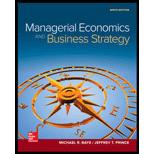
(a)
To find the reason for less marginal cost of firm 1.
(a)
Explanation of Solution
Firm 1 is an old firm which is operating from last 1 year in industry. It is operating at economies of scale. So, its marginal cost would be lower than the new firm.
(b)
To analyze current profit of two firms.
(b)
Explanation of Solution
Industry’s inverse
Market
The market
For firm 1:
Total revenue can be calculated as:
Total cost is the summation of variable cost and fixed cost. Fixed cost is $2 million. Variable cost can be calculated as:
Total cost is:
For firm 2,
Total revenue can be calculated as:
Total cost is the summation of variable cost and fixed cost. Fixed cost is $2 million. Variable cost can be calculated as:
Total cost is:
(c)
To analyze the effect of decrease in price by firm 1.
(c)
Explanation of Solution
When firm 1 decreases the price to $10, he captures whole market share.
Industry’s inverse demand function is given as:
For firm 1,
Price is charged $10. At equilibrium level of market, P = MC
The equilibrium quantity for firm 1 is 2 million.
Total revenue can be calculated as:
Total cost is the summation of variable cost and fixed cost. Fixed cost is $2 million. Variable cost can be calculated as:
Total cost is:
Firm 2:
Firm 2 loses its entire market share as it charges $15.
Total revenue can be calculated as:
Total cost is the summation of variable cost and fixed cost. Fixed cost is $2 million. Variable cost can be calculated as:
Total cost is:
Hence, firm 2 is incurring a loss of $2 million.
(d)
To analyze whether the firm 1 has incentive to raise price after the exit of firm 2 from the market.
(d)
Explanation of Solution
When the firm 2 exits the market, firm 1 is the sole producer. It has
(e)
To analyze whether the firm 1 is engaged in predatory pricing.
(e)
Explanation of Solution
Predatory pricing is the act of pricing products or services so low that other competitors are not able to compete and are forced to leave the market.
The marginal cost of firm 2 is $10. When the price was $15, both the firms were earning extra normal profits. When the firm 1 lowers its price to $10, the firm 2 can also lower its price in order to capture the equal market share. In this manner, its price would be equal to the MC. He would be on equilibrium.
Hence, the firm 1 has not done predatory pricing. Firm 2 can compete with firm 1 till $10 because the MC of firm 2 is $10.
When the firm 1 lowers the price below 10, then it would be called predatory pricing.
Want to see more full solutions like this?
Chapter 13 Solutions
Gen Combo Managerial Economics & Business Strategy; Connect Access Card
- how commond economies relate to principle Of Economics ?arrow_forwardCritically analyse the five (5) characteristics of Ubuntu and provide examples of how they apply to the National Health Insurance (NHI) in South Africa.arrow_forwardCritically analyse the five (5) characteristics of Ubuntu and provide examples of how they apply to the National Health Insurance (NHI) in South Africa.arrow_forward
- Outline the nine (9) consumer rights as specified in the Consumer Rights Act in South Africa.arrow_forwardIn what ways could you show the attractiveness of Philippines in the form of videos/campaigns to foreign investors? Cite 10 examples.arrow_forwardExplain the following terms and provide an example for each term: • Corruption • Fraud • Briberyarrow_forward
- In what ways could you show the attractiveness of a country in the form of videos/campaigns?arrow_forwardWith the VBS scenario in mind, debate with your own words the view that stakeholders are the primary reason why business ethics must be implemented.arrow_forwardThe unethical decisions taken by the VBS management affected the lives of many of their clients who trusted their business and services You are appointed as an ethics officer at Tyme Bank. Advise the management regarding the role of legislation in South Africa in providing the legal framework for business operations.arrow_forward
 Managerial Economics: Applications, Strategies an...EconomicsISBN:9781305506381Author:James R. McGuigan, R. Charles Moyer, Frederick H.deB. HarrisPublisher:Cengage Learning
Managerial Economics: Applications, Strategies an...EconomicsISBN:9781305506381Author:James R. McGuigan, R. Charles Moyer, Frederick H.deB. HarrisPublisher:Cengage Learning Managerial Economics: A Problem Solving ApproachEconomicsISBN:9781337106665Author:Luke M. Froeb, Brian T. McCann, Michael R. Ward, Mike ShorPublisher:Cengage Learning
Managerial Economics: A Problem Solving ApproachEconomicsISBN:9781337106665Author:Luke M. Froeb, Brian T. McCann, Michael R. Ward, Mike ShorPublisher:Cengage Learning







